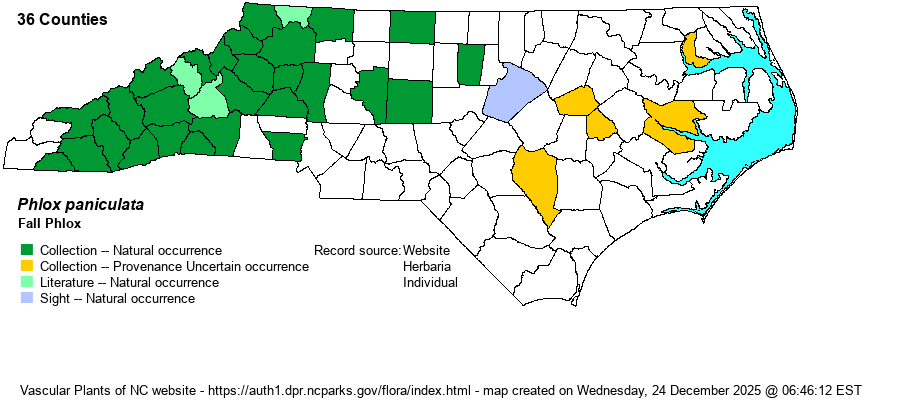| Author | L. | |
| Distribution | Present over nearly all of the Mountains; found over most of the upper Piedmont, but widely scattered in the rest of the Piedmont. Probably absent in many eastern NC Piedmont counties. Scattered in the Coastal Plain, where the website editors are considering the species probably not native. The editors are choosing to forgo iNaturalist photo records for the Piedmont owing to uncertain identification and provenance.
This is a widespread species of the Northern and Midwestern states; ranging south to central NC, northern GA, and northern LA. This species has a proclivity to escape, and thus many records from the southern counties are likely not natural. | |
| Abundance | Fairly common in the Mountains; rare to uncommon in the western third of the Piedmont, but very rare into the eastern portions (to Orange and Wake counties). Might not be native as far east as Orange and Wake counties, and probably is not native to the Coastal Plain. | |
| Habitat | This is primarily a species of moist to damp soil, but it has a somewhat disturbing habit of growing in weedy places and thus likely is not natural in some places even in the mountains and western Piedmont. It grows in wet to moist meadows, damp wooded borders, along margins of streams, and various moist to mesic clearings - including roadsides and thickets. It prefers partial sun and is not often found in forest interiors. | |
| Phenology | Blooms from July to August, and fruits mainly in September. | |
| Identification | This is normally the tallest and most robust species of Phlox in the state, usually growing to 5 feet tall, and rarely to 6-7 feet tall. It is quite leafy, with 15-40 nodes along the stem where the opposite leaves are found. The larger leaves are widely lanceolate to ovate, about 4-5 inches long and about 1.5 inches wide, thus about 3 times longer than wide. The inflorescence at the top of the stem is rather densely flowered, and is a large panicle in a pyramid shape, often 4-5 inches tall and wide. The flowers are typical for the genus, being rose-pink, tubular, and with the 5 flaring lobes, and a spread flower about 1-inch across. The species is most similar to the scarce P. amplifolia, which has many fewer leaves (often just 8-15 nodes); all leaves opposite, as opposed to some sub-opposite or alternate near the top of the stem in P. paniculata; wider leaves that are often somewhat diamond-shaped; and a glabrous corolla tube, as opposed to pubescent in P. paniculata. This is a familiar species to most biologists in the western part of the state, being the tall and robust one growing in damp or often weedy places. | |
| Taxonomic Comments | None
| |
| Other Common Name(s) | Garden Phlox, Summer Phlox, Tall Phlox | |
| State Rank | S3? [S3S4] | |
| Global Rank | G5 | |
| State Status | | |
| US Status | | |
| USACE-agcp | FACU link |
| USACE-emp | FACU link |

